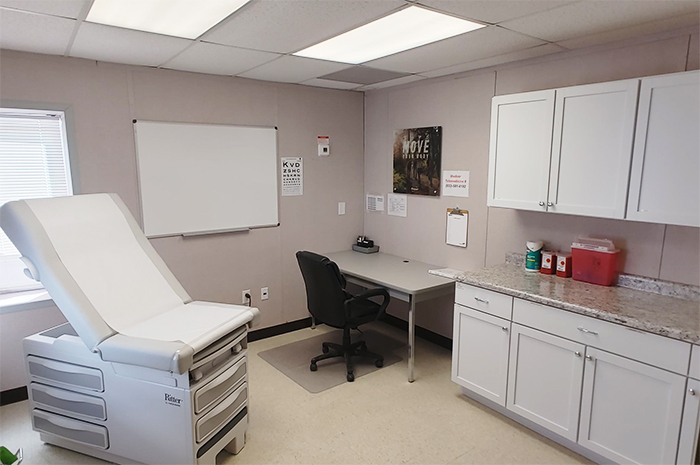What is an Occupational Health Clinic?

When an employee is injured at work, they don’t always know where to go for the appropriate level of care. Do they visit their doctor’s office? Head for the emergency room? Is onsite first aid sufficient?
Having convenient care for work-related injuries and illnesses eliminates confusion and gets injured employees the right care, at the right time and in the right place. This saves you money on unnecessary emergency care and workers’ compensation claims while improving overall employee health and satisfaction.
Onsite occupational health clinics are dedicated medical facilities that operate at or near your business, providing emergency and essential care for your employees.
What Services Are Offered at an Occupational Clinic?
Onsite clinics provide medical care for workers injured on the job, as well as other healthcare services. Offering occupational health services helps manage an employee’s work-related injury from initial treatment through their return to work, helping you avoid unnecessary care and claims.
When a referral to outside care is necessary, Medcor guides patients through provider selection and the traditional healthcare system to ensure the best health outcomes and the most savings. Some services offered by occupational health clinics include:
Occupational Medicine
Occupational medicine is a branch of medicine focused on care for work-related injuries. This can range from onsite first aid for cuts, burns and sprains to referral to outside providers, from ongoing wound care to return-to-work evaluations. Medcor delivers occupational medicine services through our onsite clinics, injury triage and telemedicine.
Physical Therapy
In many cases, physical therapy is prescribed following an on-the-job injury to help strengthen the injured area for safe return to work. Having onsite physical therapy services allows your employees to have one convenient location where they receive their care, in surroundings that are familiar to them. This helps to boost the chances they’ll follow through with their prescribed care, heal more quickly and return to work sooner.
Injury Care
No matter how minor, injuries require diligent, experienced care to ensure they don’t get worse. With convenient onsite occupational health clinics, your employees can receive the care they need for all their work-related and non-work-related injuries.
Physical Exams
Regular physicals are part of maintaining a healthy, safe and productive workforce. By providing these exams onsite, your employees have a comfortable, familiar place to go for their medical care. This empowers them to take care of their own health, which in turn benefits your business with a reduction in workplace injuries and sick days.
Medical Specialists
Medcor’s medical specialists are health advocates without conflicts of interest. They are devoted to the care of your workers and specially trained in the services they provide. Providers include physicians (MD and DO), Pas, NPs, RNs and EMTs and paramedics.
Injury Triage
Necessary medical care doesn’t always happen during regular business hours. Optional injury triage services from Medcor give you 24/7 access to our trained triage nurses, even when you don’t have one onsite at your clinic. This results in the best possible physical recommendations for injured or ill workers.
Tests and Screenings
Workplace health and safety is more than just preventing and treating injuries; it also requires a dedication to preventing the spread of disease. Employees can be screened for chronic illnesses or tested for acute diseases such as COVID-19 at Medcor clinics. Tests like X-rays and EKGs can help diagnose chronic conditions that impact your workers’ health and wellbeing.
Immunizations
An immunized workforce misses fewer days of work due to illness, and having onsite access to these vaccines increases employee vaccination numbers. Occupational health clinics by Medcor can offer immunizations, including the COVID-19 vaccine and annual flu shots.
How to Start an Occupational Health Clinic
You can start an occupational health clinic by developing a program in-house or partnering with an occupational healthcare vendor such as Medcor. No matter which option you choose, follow these steps to set your program up for success:
- Assess your needs: No two organizations are alike, and no two onsite clinics should be exactly the same. Find your organization’s unique occupational health needs and build them into your clinic’s design.
- Set goals and objectives: Determine what metrics you need to measure to ensure your program is a success, such as workers’ comp costs, injury rates and healthcare cost savings.
- Budget for setup: Whether you’re entirely funding clinic setup from your organization’s budget or you’ll explore outside options, figuring out how much you’ll need to get your clinic off the ground — and how much it will cost to run annually — running the numbers is essential.